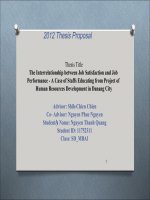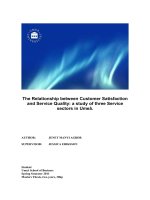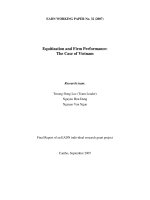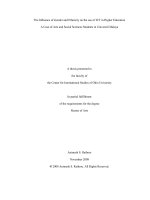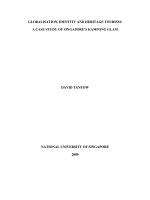Interaction effects between FDI growth and institutional environment a case of vietnam, 2008 2011
Bạn đang xem bản rút gọn của tài liệu. Xem và tải ngay bản đầy đủ của tài liệu tại đây (1.24 MB, 62 trang )
UNIVERSITY OF ECONOMICS
HO CHI MINH CITY
VIETNAM
INSTITUTE OF SOCIAL STUDIES
THE HAGUE
THE NETHERLANDS
VIETNAM – NETHERLANDS
PROGRAMME FOR M.A IN DEVELOPMENT ECONOMICS
INTERACTION EFFECTS BETWEEN
FDI GROWTH AND INSTITUTIONAL ENVIRONMENT A CASE OF VIETNAM, 2008-2011
A thesis submitted in partial fulfillment of the requirements for the degree of
MASTER OF ART IN DEVELOPMENT ECONOMICS
By
ĐẶNG VÕ TUẤN
Academic Supervisor:
TRƯƠNG ĐĂNG THỤY
HO CHI MINH CITY, NOVEMBER 2014
Declaration
This thesis is submitted in partial fulfillment of the requirements for the degree of Master
of Art in Development Economics to Vietnam – Netherlands Programme.
I hereby declare that this thesis has not been submitted for any degree.
To the best of my knowledge, the thesis is my own work. All sources used have been
cited and acknowledged in the thesis.
Đặng Võ Tuấn
i
Acknowledgement
I would like to express my deepest gratitude to my academic supervisor, Dr. Trương
Đăng Thụy, for his helpful comments and regular feedback in this thesis.
I am also grateful to Assoc. Prof. Dr. Nguyễn Trọng Hoài and Dr. Phạm Khánh Nam for
their great advice when this thesis is just in form of ideas.
I would like to thank all lecturers for the knowledge and lessons they gave me and thank
my classmates for their support during the time I studied at the programme.
Last but not least, my sincerest thank is for my family, especially my beloved wife.
Without their frequent encouragement as well as spiritual support, I would not have been able to
complete this thesis.
ii
Abstract
This thesis analyzes the interaction effects between FDI growth and institutional
environment in Vietnam in the period of 2008 – 2011. Detailed data of FDI, some traditional
FDI-related factors and institutional environment are consolidated from the Provincial
Competitiveness Index (PCI) Reports of Vietnamese Chamber of Commerce and Industry
(VCCI) and the U.S. Agency for International Development (USAID) and from Statistical
Yearbooks of General Statistics Office of Vietnam. Different functional forms are employed
using fix-effects technique to identify the factors affecting FDI flow into provinces in Vietnam.
The major results of the thesis show that there exists a significant relationship between
FDI inflow and institutional environment which is proxied by nine sub-indices of PCI Reports.
Although not all of those indices are significantly related to FDI in the period 2008-2011, the
PCI Reports are becoming more and more popular and a trustworthy reference source for foreign
investors prior to investing into Vietnam.
Keywords: inward FDI, institutions, Provincial Competitiveness Index (PCI), functional
forms, fix-effects technique.
iii
TABLE OF CONTENTS
Declaration ..................................................................................................................................... i
Acknowledgement ........................................................................................................................ ii
Abstract ........................................................................................................................................ iii
Table of contents .......................................................................................................................... iv
List of tables ................................................................................................................................ vii
List of figures ............................................................................................................................. viii
CHAPTER 1: INTRODUCTION .............................................................................................. 1
1.1. Problem statement........................................................................................................... 1
1.2. Research objective .......................................................................................................... 3
1.3. Research question ........................................................................................................... 4
1.4. Organization of the study................................................................................................ 4
CHAPTER 2: LITERATURE REVIEW ................................................................................. 5
2.1. Definition of Foreign Direct Investment (FDI) .............................................................. 5
2.2. The role of FDI in the economy...................................................................................... 5
2.3. Factors attracting FDI inflows ........................................................................................ 6
2.4. FDI theories .................................................................................................................... 7
2.4.1. Portfolio theory ..................................................................................................... 7
2.4.2. International trade theory ...................................................................................... 7
2.4.3. Market imperfection theory .................................................................................. 7
2.5. Concept of Institutions .................................................................................................... 8
2.6. The role of institutions in the economy .......................................................................... 9
2.7. Theories of Institutions and FDI ..................................................................................... 9
iv
2.8. Empirical studies on Institutions and FDI .................................................................... 10
CHAPTER 3: RESEARCH METHODOLOGY, VARIABLES DESCRIPTION
AND DATA SOURCE .............................................................................................................. 15
3.1. Research Methodology ................................................................................................. 15
3.2. Variables description .................................................................................................... 17
3.2.1. Foreign Direct Investment (FDI) ........................................................................ 17
3.2.2. Provincial Competitiveness Index (PCI) and nine sub-indices .......................... 17
3.2.3. Traditional variables ........................................................................................... 19
3.3. Data source ................................................................................................................... 20
CHAPTER 4: ECONOMETRIC ANALYSIS AND RESULTS .......................................... 21
4.1. An overview of Foreign direct investment (FDI) and Provincial competitiveness index
(PCI) in Vietnam from 2008 to 2011 ................................................................................... 21
4.1.1. Foreign direct investment (FDI) ......................................................................... 21
4.1.2. Provincial competitiveness index (PCI) ............................................................. 22
4.2. Overall descriptive statistics of variables ..................................................................... 23
4.3. Econometric analysis and results .................................................................................. 24
4.3.1. Entry costs – EC; Land access and security of tenure – LAST; Transparency and
access to information – TAI and Proactivity of provincial leadership – PPL .............. 25
4.3.2. Informal charges – IC; Time costs for administrative procedures and inspection –
TCPI; Business support service – BSS; Labor training – LT and
Legal institutions – LI................................................................................................... 28
4.4 Summary of key findings........................................................................................ 35
CHAPTER 5: CONCLUSION................................................................................................. 39
5.1. Conclusion and recommendation.................................................................................. 39
v
5.2. Limitation...................................................................................................................... 40
REFERENCES .......................................................................................................................... 42
APPENDIX ................................................................................................................................ 47
vi
LIST OF TABLES
Table 3.1: Summary of variables ................................................................................................ 15
Table 4.1: FDI of top ten provinces over the period from 2008 to 2011 (in million USD)........ 22
Table 4.2: PCI of top ten provinces in Vietnam from 2008 to 2011 (100-point scale) .............. 23
Table 4.3: Overall descriptive statistics of variables .................................................................. 23
Table 4.4: Econometric results of five regression models with variable
Entry costs – EC.......................................................................................................................... 25
Table 4.5: Econometric results of five regression models with variable
Informal charges – IC ................................................................................................................. 29
Table 4.6: Regression results of five significant PCI variables .................................................. 31
Table 4.7: Average marginal effects of nine PCI sub-indices .................................................... 35
vii
LIST OF FIGURES
Figure 4.1: Registered FDI in Vietnam over the period from 2008 to 2011 .............................. 21
Figure 4.2: FDI and Entry costs over period 2008-2011 ............................................................ 27
Figure 4.3: FDI and Land access and security of tenure over period 2008-2011 ....................... 27
Figure 4.4: FDI and Transparency and access to information over period 2008-2011 .............. 28
Figure 4.5: FDI and Proactivity of provincial leadership over period 2008-2011...................... 28
Figure 4.6: FDI and Informal charges score over period 2008-2011 ......................................... 31
Figure 4.7: FDI and score of Time costs for administrative procedures and inspections over
period 2008-2011 ........................................................................................................................ 34
Figure 4.8: FDI and Business support service score over period 2008-2011 ............................. 34
Figure 4.9: FDI and Labor training score over period 2008-2011 .............................................. 34
Figure 4.10: FDI and Legal institutions score over period 2008-2011 ....................................... 34
Figure 4.11: Relationship between informal charges score and inward FDI
in logarithmic model ................................................................................................................... 36
Figure 4.12: Relationship between the score of time costs for administrative procedures and
inspections and inward FDI in logarithmic model ...................................................................... 37
Figure 4.13: Relationship between business support service score and inward FDI
in linear model ............................................................................................................................ 37
Figure 4.14: Relationship between labor training score and inward FDI
in logarithmic model ................................................................................................................... 38
Figure 4.15: Relationship between legal institutions score and inward FDI
in quadratic model....................................................................................................................... 38
viii
CHAPTER 1
INTRODUCTION
1.1 Problem Statement
Foreign Direct Investment (FDI) has been playing an important role in economic growth of every
country all over the world. As the observation of UNCTAD (2003), FDI became a more and
more crucial factor in the development and integration of global economy during the last decade
of 20th century. Specifically, Romer (1993) asserted the importance of FDI to developing
countries in the aspect of removing the gap in human capital in comparison with developed
countries.
Vietnam, a typical developing country, has been paying close attention to FDI for the country’s
development. How to attract more and more FDI to the country to stimulate job creation and
economic growth is considered as one of the top priorities of the country’s government.
It is generally accepted that institutional environment is a key factor affecting inward FDI.
Being aware of this matter, provinces in Vietnam have tried to improve their institution
environment in order to increase inward FDI. Giang (2008), in a study of FDI in the Northern
Mountainous Provinces, proved that due to less transparency of local authority, this area was
reported to have poor inward FDI compared with provinces in other areas of Vietnam.
The Provincial Competitiveness Index (PCI) was developed in 2005 by the Vietnamese Chamber
of Commerce and Industry (VCCI) and the U.S. Agency for International Development (USAID)
to measure and assess the standards of economic governance of 63 provinces in Vietnam. The
PCI is, in other words, believed to reflect the efficiency of institutional environment. According
to the reports of PCI 2009 and 2011, Lao Cai and Bac Ninh tried to apply new initiatives and
solutions in economic governance more efficiently to improve their ranking from the third and
the tenth in 2009 into the first and the second in 2011. The inward FDI in Lao Cai and Bac Ninh
in 2011 subsequently increased more than 150% and 400% compared to the year 2009. In
addition, Vietnam’s government considers PCI one of the most important factors in the
enhancement of business environment as stated in Decision 19/NQ-CP dated March 18th 2014.
The government subsequently requested all provinces to pay close attention to the improving of
institutional environment in order to increase their PCI scores.
The institutional environment or institutions mentioned in this thesis could be generally defined
as the combination of several factors reflecting economic governance as recommended by PCI
1
sub-indices which are information transparency, informal charges, administrative procedures and
inspections, legal system, entry costs, land access and security of tenure, proactivity of provincial
leadership, business support service and labor training. In addition, the interpretation of
institutions and the effect of institutions on FDI are also broadly argued in the world. Rodrik and
Subramanian (2003) defined institutions as property rights protection, the application of laws and
regulations and corruption. Hodgson (2006) argued that institutions could be “as systems of
established and prevalent social rules that structure social interactions”. These “prevalent social
rules” are explained as conventions and rules. Kaufman et al. (1999), in a study of institutional
determinants of FDI, found five indicators related to economic governance which are political
instability, government efficiency, regulatory issue, rule of law and corruption. Conducting a
fuzzy-set analysis on institutions and inflows of FDI, Pajunen (2008) suggested that the
relationship between institutions and FDI is frequently generated from a combination of several
institutional indicators such as corruption, political stability, labor regulation, legal system, civil
liberties, property rights and taxation policies. Placing an emphasis on the impact of corruption,
Wei (1997, 2000) claimed that corruption and uncertainty related to corruption significantly
negatively affects FDI. Pournarakis and Varsakelis (2004) posited a hypothesis that “the higher
the institutional quality that a country exhibits the higher FDI inflow”. The institutional quality is
measured by the political institutions (political rights, civil liberties and freedom of the press)
and corruption. Arguing that institutions are considered as one of the most important advantages
in attracting foreign investors, Bevan, Estrin and Meyer (2004) suggested that FDI is influenced
by several particular institutional indicators which are private business ownership, innovation of
banking industry, foreign exchange and trade liberalization, and the enhancement of legal
system. Busse and Hefeker (2006) conducted a research analyzing the relationship between
institutions, political risk and FDI inflows. By investigating 12 institutional indicators derived
from the dataset of 83 developing countries, the authors conclude six significant determinants of
FDI inflows, which are stability of country’s government, conflict inside and outside the country,
corruption and ethnic strain, laws and regulations, democratic responsibility of government, and
status of bureaucracy. “Good institutions in the host country have a positive impact on inward
FDI” is the result of an empirical study of Mayer et al. (2007). In this study, the authors used
“Institutional Profiles” which include 26 institutional indicators derived from a survey conducted
in 52 countries in 2001. The result shows that only variables of bureaucracy, corruption,
information, banking sector and legal institutions play an important role in attracting inward FDI.
2
Besides, weak capital concentration and employment protection tend to deter inward FDI.
Having the same observation as Mayer et al., Daude and Stein (2007) also generally asserted that
more enhanced institutions could be positively and economically significantly related to FDI
inflows. Especially, the authors claimed that some institutional factors that cause bad impact on
inward FDI are the uncertainty of policies, regulations and laws, redundant regulatory difficulty,
instability of government and lack of commitment.
Based on the argument that more FDI is originated from more enhanced institution environment
which is reflected by PCI in this thesis, and based on the fact that provinces in Vietnam have
been trying to innovate their institutional environment in order to improve their PCI ranking, it is
necessary to investigate whether good PCI result could really be considered as an impetus of
provinces’ development especially through the attracting of more inward FDI, which is believed
to positively impact on the economic growth.
The findings obtained from this clarification would subsequently be useful for Vietnam’s
government and provinces’ authorities in the estimating and assessing if strong PCI would be the
stimulus of high FDI and which elements of PCI the government should take close care of to
maximize the positive impact of PCI on FDI.
1.2 Research Objective
The main objective of this thesis is to examine the effects of institutional environment reflected
by the PCI scores on inward FDI of provinces in Vietnam.
The dataset of this thesis is generated from annual PCI reports of Vietnamese Chamber of
Commerce and Industry (VCCI) and statistical yearbook of General Statistics Office from 2008
to 2011. By applying several different econometric functional forms and running regression
models of each PCI sub-index and traditional variables, the study demonstrates that not all of
PCI sub-indices are statistically significant in explaining FDI flow into Vietnam. Only five out of
nine PCI sub-indices are proved to be determinants of inward FDI, which are informal charges,
time costs for administrative procedures and inspections, business support service, labor training
and legal institutions. The total PCI score, however, is still believed to be one of the decisive
factors of attracting inward FDI. This finding is also in line with the government’s policy of
increasing provincial competitive capacity in order to accelerate the country’s economic growth.
3
1.3 Research Question
The research is expected to answer whether a province with high total PCI score can attract more
inward FDI than a low score province. Or just the score of some PCI sub-indices, not the total
score, can explain the trend of inward FDI between provinces and provinces.
1.4 Organization of the study
The thesis includes five chapters. The first chapter which is about the importance and the reason
of conducting the thesis is clearly presented as above. The remainder of the study is organized as
follows. In Chapter two, the literature review including theoretical background and empirical
studies is outlined to support the research methodology. Chapter three provides the methodology
of constructing research model, the interpretation of independent and dependent variables and
how the thesis’s dataset is generated. The econometric analysis and major results of the study
are reported in the fourth Chapter. The last Chapter comprises conclusion and policies
recommendation.
4
CHAPTER 2
LITERATURE REVIEW
2.1 Definition of Foreign Direct Investment (FDI)
The official definition of FDI from Organization for Economic Co-operation and Development
(OECD) states that “FDI is defined as cross-border investment by a resident entity in one
economy with the objective of obtaining a lasting interest in an enterprise resident in another
economy. The lasting interest implies the existence of a long-term relationship between the direct
investor and the enterprise and a significant degree of influence by the direct investor on the
management of the enterprise. Ownership of at least 10% of the voting power, representing the
influence by the investor, is the basic criterion used” (OECD, 2008).
2.2 The role of FDI in the economy
The role of FDI in the economy has been discussed by many researchers in the world. Wang
(2009) in a study of the impact of FDI to 12 Asian countries from 1987 to 1997, using an
approach of sector-level FDI, demonstrated that FDI in manufacturing sector plays a very
important role in the countries’ economic growth. On the contrary, FDI in non-manufacturing
sectors is proved to have no significant impact on the enhancement of economic growth. By
conducting a time-series analysis of the interaction effects between FDI inflows and economic
growth in Malaysia over the period of 1970 to 2005, Mun et al. (2008) found sufficient evidence
of a strong relationship between FDI inflows and gross domestic production (GDP) and gross
national income (GNI). Specifically, the authors asserted that FDI inflows are significantly
positively related to GDP growth rate as well as GNI growth rate, which leads to the economic
growth of Malaysia. Vadlamannati and Tamazian (2009) used panel dataset derived from 80
developing countries from 1980 to 2006 to investigate the impact of FDI on the growth of
economic output per worker. The authors demonstrated that the improvement of FDI inflows
causes positive impact on output growth in developing countries. Another interesting empirical
study about the relationship between FDI and economic growth in both direct and indirect
approach was conducted by Li and Liu (2005). By analyzing a panel dataset collected from 84
countries over the period 1970 to 1999, the authors found that FDI inflows itself directly exert a
significant positive impact on the countries’ economic growth. Besides, the conjunction of FDI
and human capital is proved to indirectly promote economic growth. Meanwhile, if FDI inflows
are combined with technology gap, a strong negative effect will be caused to economic growth of
5
developing countries. The role of FDI in the economic growth of Vietnam is the main objective
of the empirical study of Nguyen et al. (2012). In this study, Nguyen et al. applied fixed-effects
estimation method based on a panel dataset of all 63 provinces in Vietnam from 2000 to 2010
and drew an overall conclusion that FDI inflows has a positive impact on the economic growth
of Vietnam.
2.3 Factors attracting FDI inflows
By a cointegration estimation study on FDI focusing on South Asia area, in particular five
countries India, Bangladesh, Pakistan, Nepal and Sri Lanka, Sahoo (2006) shows that there exists
a long-run equilibrium nexus between FDI and its determinants. The author points out that the
key factors of FDI in this area comprise of market size, growth of human capital, infrastructure
and trade openness, in which the most significant determinants are market size and growth of
human capital. The author emphasizes that it is essential for South Asian countries to improve
development momentum to enhance market size, policies framework to take advantage of their
surplus of labor force, enhance infrastructure facilities and promote policies of trade openness for
more FDI attracting. One of the primary determinants of FDI is education is the result of an
econometric model conducted by Nonnemberg and Mendonca (2004) in 38 developing countries.
FDI in developing countries, in other words, has been demonstrated to involve knowledgeintensity activities. In addition, the openness of the economy was proved to play an important
and significant role in the attracting of foreign investments. Finally, by running a causality test
between FDI and gross domestic output, the authors asserted that gross domestic output induces
FDI. In a report of FDI determinants in China, Dang (2008) claimed that local market is firstly
advantage that FDI investor would like to take. Secondly, the investors always prefer lower
production costs which could be achieve from cheap labor cost in China. Next, FDI inflow to
China tends to be highly influenced by the quality of infrastructure. Qualified infrastructure
enables firms to develop their technology in order to gain economies of scale and scope. Finally,
governmental environment is considered as a significant determinant in the attracting of FDI in
China. This is because political leaders or policy makers could cause some impacts on the
growth and development of the country. In a research of FDI of the Northern Mountainous
Provinces in Vietnam, Giang (2008) suggested that there are some factors impacting the FDI of
this area which are the distance from a business center of a country, infrastructure, FDI policy
and FDI environment. According to annual surveys conducted by Vietnam Chamber of
Commerce and Industry in Northern Mountainous Provinces, FDI environment of this area is
6
considered not favorable compared to other areas in Vietnam. Anh and Thang (2007) observed
that some important factors which foreign investors tend to consider when they make a location
decision comprise of potential of market, human capital and infrastructure.
2.4 FDI theories
2.4.1 Portfolio theory
According to portfolio approach of Markowitz (1952) and Tobin (1958), part of the surplus
profits which should be gained in international markets are simply compensation for higher risk
associated with this alternative use of capital. The rates of return generated from differential
investments should be connected to a factor of risk in the selection between substitutable
properties to construct an effective portfolio. Dunning (1973) provided an explanation why the
portfolio theory is only able to partially demonstrate FDI. Because this theory neglects the fact
that direct investment has no relationship with changes in ownership. It is, however, related to
the investment of element inputs other than capital, which are entrepreneurship, technology and
management experience, and could be influenced by the relative profitability of the use of these
factors in different countries as that of money capital.
2.4.2 International trade theory
Mundell (1957) developed the classic model to demonstrate that trade and capital transmission
could be substitutes. In other words, trade tariffs could cause FDI flows into the protected
countries. This statement is the same as original Heckscher-Ohlin model, in which the barrier on
trade could be modified by foreign transmission of factors, specifically capital, given the
immobility of labor. Kojima (1973), in his macroeconomic approach, classified the aims of FDI
into four categories: (i) to exploit natural resources (ii) to use cheap labor cost in host country
(iii) to avoid tariff and non-tariff barriers and (iv) to take advantage of oligopolistic capability
due to the advantage of technology and knowledge.
2.4.3 Market imperfection theory
Hymer (1960), in the Hymer-Kindleberger hypothesis, argued that since there usually exist some
disadvantages imposed to foreign firms in comparison with domestic firms such as knowledge
and experience of market, communication, foreign firm should maintain some firm-specific
advantages in case they have a plan of foreign production. In addition, Hymer (1960)
emphasized that FDI is not merely about the capital transfer; FDI is also related to the
international transmission of possession and intangible assets - techniques, business facilities,
and skilled labor. Hymer (1960) asserted that the imperfection of the foreign markets for those
7
assets induces the presence of FDI. By taking advantage of direct investment, firms can
internalize or remove these market imperfections.
2.5 Concept of Institutions
A wide range of theories and approaches of FDI determinants have been conducted due to FDI
applicability. According to this thesis’s objective, institutional environment or institutions is
believed to be crucial theoretical background of FDI decision-making.
Conducting a study of institutional economics, Commons (1931) proposed a general definition of
institution as “collective action in control, liberation and expansion of individual action”.
Commons interpreted collective action is not only the “control of individual action”, but it is also
the “liberation of individual action” from compulsion, pressure, prejudice or injustice in
individuals’ competition. In addition, collective action is expansion of the determination of the
individual much more than what he can do by his own ability.
Discussing institutional changes, North (1990) defined “institutions are the rules of the game in
society, or more formally, are the humanly devised constraints that shape human interaction. In
consequence they structure incentives in human exchange, whether political, social, or
economic.”
Hodgson (2006) proposed that institutions could be understood as structures of established and
common social rules that establish social interactions. According to Hodgson (2006), “the term
rule is broadly understood as a socially transmitted and customary normative injunction or
immanently normative disposition”, in which “immanently normative requires that if the rule is
scrutinized or contested, then normative issues will emerge” and “socially transmitted means that
the replication of such rules depends upon a developed social culture and some use of language”.
Nelson and Sampat (2001) constructed a concept of institutions as “standard social
technologies”. The phrase “social technologies” is partly similar to “physical technologies”
because in addition to physical engineering, “social technologies” are more associated with
human interaction. The authors concluded that institutions could be considered as a determinant
of economic performance or economic growth by the combination of physical and social
technologies.
A new way of the approaching of institutions concept was constructed by Roversi (2013). He
introduced two new supplementary concepts which are meta-institutional concept and parainstitutional concept. Meta-institutional concepts are interpreted as “aim-oriented” and “valueoriented”, in which “aim-oriented” involves the consideration of a purpose or an inside objective
8
of general social practice; while “value-oriented” is pertained to the ordinary values and basis of
general social practice. Para-institutional concepts include “act-describing” and “factdescribing”, in which “act-describing” describes common action, performance or planning; while
“fact-describing” describes specific aspects of real institutional practice. These two
supplementary concepts are linked to each other by “constitutive rules”; “constitutive rules”, in
other words, is considered as a crucial determinant of the creation of institutional reality.
2.6 The role of institutions in the economy
The theme of analyzing the role of institutions in emerging economies has been conducted by
many researchers. Scott (1995) suggested that theory of institutions accentuates the impacts of
the system around organizations that create behavior of society and organizations. Peng and
Heath (1996) stated that in transition economies, firms have to face difficulties in the
enhancement of internal growth due to institutional constraints. Consequently, a strategy
focusing on network-based growth is believed to be more reasonable in emerging economies.
Lau (1998) observed Chinese enterprises and asserted that these enterprises also coped with
institutional constraints which are political and market pressure. Having the same idea but
Suhomlinova (1999) applied the study on Russian enterprises and declared that government
institutions and influences could be considered as institutional constraints for the innovation of
the enterprises in Russia.
Placing an emphasis on the economic reform of large state-owned enterprises, Child and Lu
(1996) proved that material, relational, and cultural constraints prevented the reform from
moving smoothly. Jefferson and Rawski (1995) attributed the success of the industrial reform in
China to institutional changes, the mitigation of state ownership and control and development of
private property rights. Institutional changes are believed to provide appropriate stimulus and
changes in enterprises’ culture which empowered firms, even state-owned ones, to make
enhancements. By applying the same approach of the benefits from institutional changes,
Soulsby and Clark (1996) demonstrated that basic and primary institutional changes have
contributed to a reinstitutionalization of management through the acquirement of administrative
expertise which is more applicable to the new environment and useful for strategic decision
making.
2.7 Theories of Institutions and FDI
An important point about the effects of institutions on FDI is related to transaction costs. North
(1990) argued that institutions influence societal interactions and organizational action. By
9
affecting the transaction costs and information costs due to the diminishing of uncertainty and
the construction of a substantial structure that promotes interactions, institutions impact on the
making decision of FDI and FDI implementation. In particular, this mindset highlights that costs
are usually incurred when firms are involved in business transactions, which are the cost of
collecting information, composing and administering contracts. North (1990) also mentions that
the effectiveness of political institutions might be assessed by how closely a political market
estimates a zero transaction cost result. Specifically, about multinational enterprises and FDI
decision making, a country is believed to achieve more inward FDI if the institutional
environment could estimate transaction costs close to zero. Berge (2012) demonstrates that
institutions may influence nation-level profitability assessments, and is, therefore, likely to be a
significant factor of FDI. These profitability assessments comprise lower transportation and
communication costs along with more available resources and facilities for multinational
enterprises. New institutional economics is the theoretical foundation that Gross and Trevino
(2005) applied to examine the interaction effects between FDI activity and institutional
development. The authors argued that FDI is influenced by country-level macroeconomic,
microeconomic, and institutional changes. These institutional changes are specifically related to
factors that diminish or increase the unpredictability and costs pertaining to capital investment in
long term.
Theories regarding government, legal system, corruption and infrastructure are some other
significant aspects in analyzing the effects of institutions and inward FDI. Meyer (2001) found
that there is increasing evidence that governments in transitional economies, when attempt for
more global FDI flows, have adjusted their institutional reality in order to attract inward FDI.
Mentioning empirical literature on FDI determinants, Blonigen (2005) considered institutions a
crucial determinant of FDI, especially for less-developed countries. Firstly, insufficient legal
protection of assets could lead a firm’s assets to the possibility of expropriation, which in turn
probably make investment less possible. Next, low quality of institutions required for wellfunctioning market and corruption could boost business costs and reduce FDI activity
correspondingly. Last but not least, substandard institutions easily lead to weak infrastructure,
low expected profitability, which subsequently decreases FDI flow into a market.
2.8 Empirical studies on Institutions and FDI
A typical approach of institutions and FDI has been used by many researchers, which is the
analyzing of several countries in some specific regions and pointing out significant institutional
10
factors affecting inward FDI. By conducting a research about FDI flows into Latin America
during the period of 1990-2006, Ramirez (2010) mentions some institutional factors pertaining to
FDI decision-making, which include political and macroeconomic stability, the nature and extent
of governmental policies related to infrastructure and labor force and an organization of a legalinstitutional framework which is favorable for business performance. Gross and Trevino (2005)
in an analysis about the relationship between FDI inflows in Central and Eastern Europe and
institution building argued that institutional factors which affect FDI decision-making include
corruption, political risk, bilateral investment agreements and transaction costs. In particular, the
existence of corruption and political risk are demonstrated to be negatively related to inward
FDI. The applying of bilateral investment agreement has positive significant impact on FDI
inflows. Campos and Kinoshita (2003) conducted a research from transition economies in
Central Europe and the former Soviet Union in the period of 1990 and 1998 and found that
institutional quality plays an important role in the location decision of foreign investors. The
authors interpret the good quality of institutions in terms of low level of corruption, an unbiased,
predictable and transparent judiciary, and an effective bureaucracy. Continue to focus on 45
developing countries in the African, Latin American and Asian regions, Bissoon (2011) attempts
to interpret the crucial role of institutional quality in FDI flows. In particular, the study points out
that good institutional quality in terms of controllable inflation rate, effective control of
corruption, good legal system, political stability and better freedom of the press would have a
positive impact on the FDI inflows of the countries. Alemu (2012) conducted an empirical study
on FDI inflows and institutions, using panel dataset collected in 16 Asian economies from 1995
to 2009. The author made an emphasis on the effect of corruption level only and found obviously
negative impact of corruption on the FDI attractiveness in the Asian countries.
Another type of approaching institutions is the examining of multinational enterprises. Using
evidence from United State multinationals investing in many different regions in China, Du et al.
(2008) investigated the impacts of economic institutions on location choice of FDI. The authors
observed that US enterprises prioritize their investment into the regions with high protection of
intellectual property rights, less intervention of government in business operations, lower degree
of government corruption, and more efficient contract enforcement.
Some other researchers aim to an overall approach of institutions. Selecting India which is a
country with rapid growth in FDI inflow during five years from 1996 to 2000 to examine the
relationship between institutions and inward FDI, Collins et al. (2008) proposed hypotheses of
11
overall institutional environment and three institutional dimensions including “regulative,
cognitive and normative institutions”. In which, overall institution environment represented by
ranking of business environment has a positive relationship with FDI inward. Regulative
institutions are about rule of law, regulations and policies. Cognitive institutions are related to
scenarios or frameworks that people obtain meaning from and explain symbolic representations
of the world. Normative institutions describe the values and principles that illustrate socially
proper ways of behavior. The two institutional dimensions – regulative and cognitive institutions
– are proved to be positively related to FDI flows into India. Regulative institutions are proved to
have strongest influence on investment into India. It supports potential foreign investors with
difficulty in coping with regulatory matters as well as the availability of legal knowledge
required for investment transaction into India. Meanwhile, cognitive institutions provide firms
with appraisal knowledge and deal evaluating expertise. Normative institutions, on the contrary,
are proved to have no statistically significant impact on FDI flow into India. Conducting the
same approach of institutional environment in terms of regulative, cognitive and normative
institutions, Trevino et al. (2008) drew a different conclusion when they apply their study in
Latin America between 1970 and 2000. The authors argued that cognitive and normative types
proxied by bilateral investment treaties, educational achievement, privatization and political
unpredictability were proved to have significant relationship with FDI flow into Latin America.
Regulative type, whereas, proxied by tax and trade reform, financial account liberalization were
not important determinant of inward FDI into this area.
Unlike other researchers conducting studies about institutions and FDI at country level,
province-level approach and sector-level approach are alternative options. Cole et al. (2009) had
a new approach of institutions and FDI when they introduced a province-level analysis of the
relationship between FDI location and institutions in terms of corruption and governance in
China from 1999 to 2003. The authors used the number of convictions of public officials as a
proxy for corruption level at each province. Besides, anti-corruption effort is proxied by the
number of recorded cases under inspection by procurator’s offices. Those cases include bribery,
misappropriation of public reserves, illegitimate ownership of public funds, unstated source of
large property, abuse of power, abandonment of duty and responsibility and deceptive practices.
The governance efficiency is illustrated in terms of public services, public goods, government
scale, and national welfare. The empirical results of the study revealed that better governance
efficiency could lead to economic growth, which means provinces with good local governance
12
would be able to attract more inward FDI. In addition, foreign investors usually tend to direct
their investment into provinces with high achievement in anti-corruption effort, as proved by the
study’s econometric results. “Do Institutions Matter for FDI?” is the title of an empirical study
conducted by Ali et al. (2010). The authors used a panel dataset generated from 69 countries over
the period from 1981 to 2005 and concluded that a robust determinant of FDI is institutions. In
addition, the protection of property rights is proved to be the most significant institutional factor
that affects FDI inflows. Furthermore, by applying sector-level approach to analyze the impact of
institutions on FDI, Ali et al. argued that institutional quality exerts different effects on different
sector in the economy. In particular, in primary sector which is proxied by natural resource
availability; the level of taxation; and the quality of transport infrastructure, the authors found no
significant impact of institutions on FDI. On the contrary, institutional quality is proved to
significantly matter for FDI in manufacturing sector, particularly in services.
Analyzing a new concept of institutions, Seyoum (2009) conducted an empirical study of the
relationship between “formal institutions” and FDI inflows. According to the author, “formal
institutions” is a combination of independence of judicature, effectiveness of legal system,
protection of property rights and intellectual property rights, unfairness in the decision making of
authorities, capability of law-making parties, and efficiency of antitrust policy. The results of the
study reveal that host countries with strong formal institutions would be able to attract more FDI
inflows. Seyoum, in addition, conducted further investigation on the difference in institutional
environment between home and host countries and demonstrated that a large distance in
institutional levels between the home and host countries would lead to a significant negative
impact on FDI inflows.
By focusing on a particular region in the world – ASEAN – Masron and Abdullah (2010) made
an observation on the interaction effects between institutional quality and FDI inflows for the
period from 1996 to 2008. The authors used six World Bank’s Worldwide Governance Indicators
in order to represent institutional quality, which are (i) political freedom, freedom of expression,
association, and the press; (ii) political stability and absence of violence; (iii) government
effectiveness; (iv) regulatory quality; (v) rule of law, quality of property rights, the police, and
the courts and (vi) corruption level. The results of the study reveal that the more enhanced
institutional quality, the more FDI inflows would be attracted into the region. Besides, the
authors claimed that the impact of institutions on FDI in ASEAN in the period 1996-2008 is
relatively low. This is because ASEAN countries have not focused seriously on the improvement
13
of institutional quality. Therefore, the promoting of the quality of institutional environment
should be considered as a decisive future policy strategy for the further significant attraction of
FDI inflows into the regions.
14
CHAPTER 3
RESEARCH METHODOLOGY, VARIABLES DESCRIPTION AND DATA SOURCE
3.1 Research Methodology
Investigating the nature of the relationship between FDI inflows and institutional quality as well
as several traditional FDI-related factors in 63 provinces in Vietnam is considered as the major
objective of this study.
In order to achieve this research objective, a general econometric model is proposed as below:
f(FDI)it = f(Institutions, Traditional)it + uit
In which, the institutions variable is proxied by the Provincial Competitiveness Index – PCI and
traditional variables are derived from theoretical background and empirical studies analyzed
above. i denotes provinces in dataset, t denotes time (year) from 2008 to 2011 and u denotes
residuals. The dependent and independent variables mentioned in this study are briefly
introduced in Table 3.1 below.
Table 3.1: Summary of variables
Concept
Variable
Definition
direct Registered
foreign
Measurement Unit
Dependent
Foreign
direct Million USD
variable
investment
investment
Institutions
Entry costs
Costs of starting up firms’ 10-point scale
Symbol
FDI
EC
business
Institutions
Land
access
and Difficulty in land access and 10-point scale
security of tenure
the
stability
of
LAST
acquired
business premises.
Institutions
Transparency
access
Institutions
and Ability of accessing plans and 10-point scale
TAI
to legal documents related to
information
firms’ business
Informal charges
Informal charges that firms 10-point scale
IC
are required to pay
Institutions
Time
costs
for Time spent for bureaucratic 10-point scale
administrative
procedures
compliance and inspections.
and
15
TCPI
inspections
Institutions
Proactivity
of Creativity and ingenuity of 10-point scale
provincial leadership
Institutions
Institutions
provinces’ leaders
support The availability of provinces’ 10-point scale
Business
PPL
service
support services
Labor training
The assessment of provinces’ 10-point scale
BSS
LT
leaders in labor training
Institutions
Legal institutions
Private sector’s trust in the 10-point scale
LI
provincial legal institutions
Tradition
Infrastructure
Roads paved with asphalt
Percentage
Tradition
Market size
Gross retail sales of goods Billion VND
INF
MS
and services
Tradition
Tradition
Industrial product of Gross output of provinces’ Billion VND
IP
province
industry
Labor force
Population at 15 years of age Thousand persons
LF
and above
Tradition
Major
region
economic Four major economic regions Dummy
variable MER
- Northern, Southern, Central with value of 0 and 1
and Mekong Delta.
There are some different functional forms that could be employed to analyze the interaction
effects between institutional environment and FDI inflow, which are linear, quadratic and
logarithmic functional form. Five regression models generated from these three functional forms
include linear FDI-linear PCI, linear FDI-quadratic PCI, linear FDI-logarithmic PCI, logarithmic
FDI-linear PCI and logarithmic FDI-logarithmic PCI. In order to avoid multicollinearity which
may happen when all PCI sub-indices are included in one model, each PCI sub-index would be
analyzed along with five traditional variables instead. There are nine PCI sub-indices and this
means the total number of regression models generated from five functional forms would be
forty five models. All of those regression models are conducted by using fixed-effects technique.
The most appropriate model would be identified and this model would precisely point out which
PCI sub-indices are statistically significantly impact FDI inflows.
16


